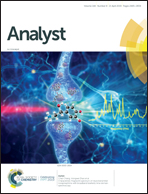A fluorescent sensor for folic acid based on crown ether-bridged bis-tetraphenylethylene†
Abstract
Aggregation-induced emission (AIE) provides a new strategy for preparing fluorescent sensors in aggregated state. In this paper, a series of crown ether-bridged bis-tetraphenylethylene compounds were synthesized in 78–84% yield by a simple procedure. The molecules exhibited excellent AIE properties in THF/H2O solutions and solid films. The investigation on sensing abilities for various biomolecules and metal ions suggested that Bis-TPE-1 possessed obvious response to folic acid, with fluorescence enhancement and blue shift of maximum emission wavelength from 380 nm to 365 nm. The detection limit for folic acid was 6.36 × 10−7 M, and the sensor's selectivity for folic acid was little interfered by the other species. The sensor mechanism was studied by FT-IR, 1H NMR, MS spectra and fluorescence Jobs’ plot. The selective sensor for folic acid was applied in test paper and the analyses of real samples of mung bean and spinach. The superior bioimaging performance of Bis-TPE-1 for sensing folic acid was confirmed by the live cell imaging experiments, which indicated its good practical application potential for detecting folic acid.



 Please wait while we load your content...
Please wait while we load your content...